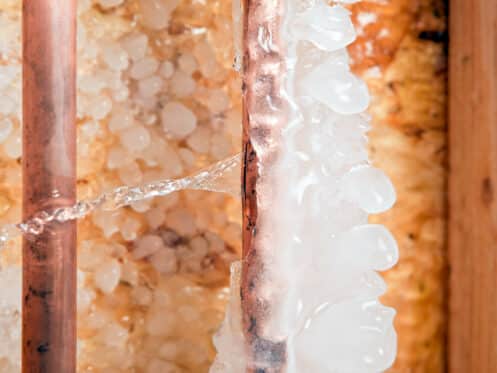Would it surprise you to know that over 250,000 homes are affected by frozen pipes each winter? It’s a chilling statistic that highlights the real threat winter poses to our pipes. As the temperatures drop, the risk of pipes freezing and bursting increases, leading to water damage and hefty repair bills. Insurance providers report that as much as 20% of insurance claims are due to frozen pipes and water damage.
A burst water pipe can cause extensive damage and cost a lot of money to repair. However, they can also be easily prevented. Follow these 10 tips to protect your home from frozen pipes in winter.
1. Insulate Exterior Walls
Not having enough insulation makes it hard for homes to retain heat, allowing exterior wall spaces to become cold enough to freeze nearby pipes, even on mildly cold days. Evaluate your insulation, prioritizing exterior southern wall exposure which bears the brunt of winter wind chill. Most homes do best with an overall R-15 to R-21 insulation value but increase levels to R-30+ in attics, and R-60 on exterior walls for better freeze prevention.
The recommended R-value for attic insulation is significantly higher in colder northern climates than in warmer climates. The generally recommended R-value for attics is R-38, which provides a baseline for thermal resistance. However, for optimal insulation performance, especially in New England areas, we recommend aiming for an R-value between R-50 and R-60.
When thinking about insulation in cold climates, the focus shifts to creating a robust layer of insulation, 10 to 14 inches, to combat harsh weather conditions.
2. Wrap Pipes
One effective strategy is wrapping insulating material around pipes in unheated spaces. Consider using materials like foam tubing or fiberglass batting wrap to create a robust insulation barrier. Pipe insulation is available pre-slit for easy wrapping. Protect vulnerable spots like elbows and fittings too using insulation pads. This is a relatively inexpensive way to protect your pipes this winter.
3. Sealing Air Leaks
Keeping cold air out is crucial. Use silicone or rubber caulk to seal cracks and gaps around pipes, as well as around windows and doors. This simple yet effective step helps retain warmth within the home, keeping temperatures consistent.
4. Apply Heat Tape
For areas at high risk of freezing, heat tape can be a lifesaver. This ingenious solution provides a controlled amount of warmth to pipes, ensuring they remain at temperatures above freezing.
5. Drain Hoses
When temperatures drop below freezing, residual water sitting in outdoor spigots, valves, and hoses expands as it turns to ice, causing pipes to crack under intense pressure.
6. Shut Off Outdoor Faucets
Every fall, make sure all outdoor faucets are properly shut off. Most have individual shut-off valves. Then open the outdoor faucet to drain the remaining water from the line so no water remains inside to freeze and expand. Disconnect all hoses too.
7. Open Cabinet Doors Under Sinks
Don’t assume the warmth of your home will keep those pipes under the bathroom sink safe. Closed cabinets prevent heat circulation, creating a cold zone right around the drain lines. Make a habit of leaving all vanity and sink cabinet doors open during freezing weather. It also allows you to quickly spot leaks.
8. Check Vents for Cold Air Streams
High on the walls of many homes are small passive air vents allowing airflow to prevent moisture and gas buildup. But vents can also funnel freezing outdoor air right onto vulnerable pipes. Evaluate vent positioning during cold snaps and use cardboard to direct cold air streams away from nearby pipes. Close unused vents until temperatures warm.
9. Keep the Heat On
The number one defense against frozen pipes is consistent indoor warmth. When bitter cold spells set in, do not turn down the thermostat if you’ll be away. Maintain at least 55°F inside the home, and open cabinet doors to allow warm air to circulate around critical areas like sinks and appliances. Consider installing a smart thermostat you can adjust remotely if a deep freeze takes you by surprise.
10. Leave Faucets Dripping
A dripping faucet can be an annoyance most of the time, but in the winter, it’s welcomed. The reason is that water that is moving doesn’t freeze as easily. Set the faucet handle so that 2 – 3 drips or a very thin stream of water runs down the sink. Be sure to do this when you know that temperatures will drop overnight.
The winter chill can be tough on plumbing, so incorporate these preventive measures to make sure you’re prepared.
Signs of Frozen Pipes
Recognizing the early indicators of frozen pipes is crucial for timely intervention and prevention of potential disasters. Keep a keen eye out for signs such as reduced water flow, where faucets may trickle instead of flowing, serving as an early warning of the impending freeze.
Another indicator is discolored water. An unusual hue may indicate that ice is obstructing the normal flow, causing discoloration. A sudden drop in water pressure is another red flag, signaling the onset of freezing, as the formation of ice blocks within pipes can restrict water movement.
Be vigilant for signs of burst pipes, such as water leaks near pipes, standing water, or water-stained walls and ceilings. Bursting is the worst-case scenario, making it all the more important to be as prepared as possible before winter hits.
What to Do If Pipes Freeze
The first thing you need to do if you come home to find that your pipes are frozen is to approach the situation cautiously and focus on safety. If more than one section of the pipe is frozen, you may need to hire a professional to thaw it out. It may require advanced techniques or specialized equipment that you don’t have to thaw larger sections of pipe without breaking. Applying direct heat can also make things worse, potentially leading to further damage.
Thawing a frozen pipe should be done slowly to avoid damaging the pipe. It may take a while, but it’s better to warm things up a little at a time instead of all at once. Options for heat include portable space heaters, heating pads or tape, blow dryers, radiator heat, and hot water bottles. Exercise care and protect your hands.
If you discover a burst pipe, shut off the main water line immediately and call a plumber for help. Knowing what to do and acting quickly will help minimize the damage and prevent further problems. For any additional piping solutions, turn to us.
Get Help From a Professional
DeWolfe Plumbing, Heating & Cooling is a premier provider of HVAC and plumbing services in Worcester County. We’re a family-owned business and have been serving our community since 1931. Our team of skilled technicians and plumbers can tackle any job related to heating, cooling, or plumbing. We can install a new dishwasher in your kitchen, or repair your furnace to keep your house warm and cozy.
Contact DeWolfe Plumbing, Heating & Cooling for plumbing repair in West Boylston.


